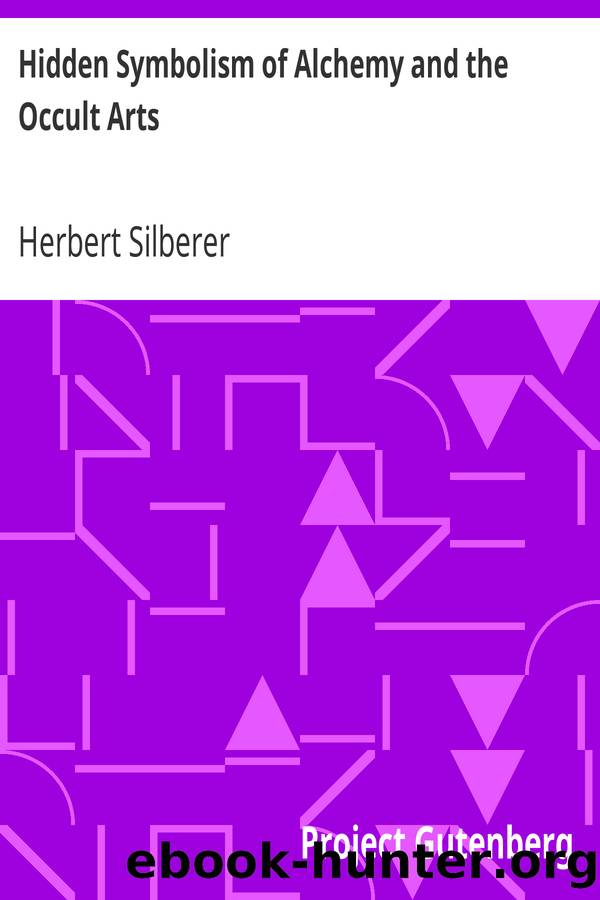Hidden Symbolism of Alchemy and the Occult Arts by Herbert Silberer

Author:Herbert Silberer [Silberer, Herbert]
Language: eng
Format: epub, pdf
Tags: Alchemy, Society of Rosicrucians, Symbolism (Psychology)
Published: 2009-01-09T00:00:00+00:00
âPlunge then.âI could as well say soar.â
We see therefore between the visualized image and the thought content, which is, as it were, represented by it, a number of relations. The whole image resolves itself insofar as it has characteristic features, almost entirely into such elements as are most closely related to the thought content. Apart from these connections of the material category, the image represents also my momentary psychic condition (transition to sleep). Whoever is going to sleep is, as it were, in the mental state of sinking into a dark sea. (The sinking into water or darkness, entrance into a forest, etc., are frequently-occurring threshold symbols.) The clearness of ideas vanishes there and everything melts together just as did the water and the atmosphere in the image.
This example is but to illustrate; it is in itself much too slight and simple to make any striking revelation of the remarkable interlacing of the two kinds of symbolism. I refer to my studies on symbolism and on dreams in the bibliography. Exhaustive treatment at this point would lead us too far afield. Let us rest satisfied then with the facts that the psychoanalysts simultaneously deal with two fundamentally different lines of interpretation in a product of the phantasy (dream, etc.), quite apart from the multiple determinants which they can find [pg 239] within the material as well as in the functional categories; both lines of interpretation are supplied by the same fabric of images, indeed often by the same elements of this image fabric. This context therefore must have been sought out artfully enough by the creative unconscious to answer the double requirement.
The coexistence of the material meaning with the functional is not entirely puzzling to the student of psychoanalysis. Two facts must be kept in mind throughout.
In the first place, we are acquainted with the principle of multiple determination or condensation. The multiplicity of the dimly moving latent dream thoughts condenses into a few clear dream forms or symbols, so that one symbol continually, as it were, appears as the representative of several ideas, and is therefore interpretable in several ways. That it should be susceptible of more than one interpretation can cause no surprise because the fundamental significance (the latent thoughts) were the very ones that, by association, caused the selection of the symbols from an infinite series of possibilities. In the shaping of the dream, and therefore in the unconscious dream work, only such pictorial elements could penetrate into consciousness as satisfied the requirements of the multiple determination. The principle of multiple determination is valid not only within the material and the functional categories, but makes the fusion of both in the symbol in question to some extent intelligible. Elements of both [pg 240] categories take an active part in the choice of the symbol. On the one hand, a number of affects press on towards the symbolic representation of objects to which they direct themselves (objects of love, hate, etc.). On the other hand, the psyche takes cognizance of its own impulses, play of affects, etc.
Download
Hidden Symbolism of Alchemy and the Occult Arts by Herbert Silberer.pdf
This site does not store any files on its server. We only index and link to content provided by other sites. Please contact the content providers to delete copyright contents if any and email us, we'll remove relevant links or contents immediately.
| Ancient & Controversial Knowledge | Ghosts & Hauntings |
| Hermetism & Rosicrucianism | Magic Studies |
| Occultism | Parapsychology |
| Supernatural | UFOs |
| Unexplained Mysteries |
Animal Frequency by Melissa Alvarez(4399)
Sigil Witchery by Laura Tempest Zakroff(4181)
Real Magic by Dean Radin PhD(4075)
Fingerprints of the Gods by Graham Hancock(3943)
Aleister Crowley: The Biography by Tobias Churton(3589)
Journeys Out of the Body by Robert Monroe(3572)
The Rosicrucians by Christopher McIntosh(3467)
Alchemy and Alchemists by C. J. S. Thompson(3452)
Mysteries by Colin Wilson(3398)
Hitler's Monsters by Eric Kurlander(3269)
The Hatha Yoga Pradipika (Translated) by Svatmarama(3235)
John Dee and the Empire of Angels by Jason Louv(3132)
Wicca: a guide for the solitary practitioner by Scott Cunningham(3127)
Infinite Energy Technologies by Finley Eversole(2939)
Book of Life by Deborah Harkness(2869)
Dark Star Rising by Gary Lachman(2830)
The Book of Lies by Aleister Crowley(2802)
Aliens by Jim Al-Khalili(2788)
To Light a Sacred Flame by Silver RavenWolf(2770)
